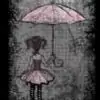Folks,
I saw from the forum yesterday that the overwhelming focus of attention in this episode, for many of you, was the scenes between Arjun and Riya, especially the shower scene and its aftermath. I can fully understand such reactions, as most of you appear to be very young, and for the young, the high romantic is the be all and end all of any story.
However, at the risk of being pelted with something squishy, I must say that for me, while both these scenes were surprisingly gentle and very moving, Arjun seemed more like a concerned adult comforting an anguished and frightened little girl, than even a potential lover with the object of his affection. He understands Riya's mental block and the consequent horror she now feels, and as it is he who has brought it about, he feels responsible for it and wants to help her out of her emotional cul de sac. As I had noted in an earlier post, that he will eventually fall in love with her is a given, but that is a good long way off as yet.
But Riya was really superb as a girl haunted by the blood and the gory death she has caused; Sana is a far better actress than the average pretty faced woman officer in, say, CID or Adaalat. The actual killing was more like something out of Anurag Kashyap's The Gangs of Wasseypur or a Quentin Tarantino film than an Indian TV cops and robbers serial – I watched it, moving the recording frame by frame, and it was really bloody and extremely well done technically.
One question, why is her left arm, the one in which she was shot earlier, in a sling after the shower scene?
As for the argument that Riya might be angry with Arjun for, in effect, hoaxing her into firing, that is a non starter. In fact, she should be thanking him for it on her knees! Riya, as she was, was a walking, talking menace for the ETF. She rushes into every melee brandishing her gun, without a clue as to what to do with it if she and/or a colleague are in mortal danger. She was bound to get herself and/or one of them killed any day, and if I had been Rathore, once I found out about this dangerous mental block of hers, I would have sent her back to the Research Section pronto. I cannot understand his not even giving her an ultimatum about this. It is downright irresponsible of any unit chief to retain a member who, however capable in other ways, is a positive danger to the rest of the team in a crisis.
All this disposed of, I would now like, if you will bear with me, to make a few points about the mystery part of the episode, which was, a few bloomers notwithstanding, a very good one in terms of the core story idea and the screenplay.
Firstly, the double jeopardy angle is a completely new one as far as Indian TV crime serials go – in fact I cannot remember any previous example of it on TV - and it comes as a total surprise because, as in all good mystery stories, the fact that Nitish Agarkar has been identified by the neighbour from Sadashiv Mahato's photo is kept from us till Arjun reveals it at the end. It is poetic justice and it wraps the story up very neatly.
This apart, the way in which the two parallel and only seemingly linked tracks – that of the ganja (marijuana) trafficking and that of the (double) murder(s) – are handled is a treat to watch.
The charas track: As for the first, the look on Shree's face when it dawns on him that he is the candidate for the young charsi khabari is a delight, and even Arjun attempts some deadpan humour here.
When they are questioning the charas distributor about Amit Ray's whereabouts, it comes as a surprise when Arjun stops Rathod's hard-fisted tactics and does a Riya on the chap, so to speak, using the emotional card of his family to get him to co-operate. This gentler approach seems to have rubbed off on him from Riya.
The whole scene of a marijuana dealer, even if he is the kingpin for that area, holed out in what looks like a Colombian drug lord's headquarters, complete with any number of thugs armed with heavy guns patrolling the place, is way over the top. Marijuana is a petty thing as far as the drugs traffic is concerned, and dealers in charas are far more likely to run when faced with the police that to engage in an all out gunfight. That sort of this is for the hard drug barons dealing in heroin and cocaine, like the Medellin mafia of Pablo Escobar and his kind.
The scene is obviously set up that way for the sole purpose of getting Riya into a situation where she has to shoot. The earlier acrobatic exercise which Arjun has to carry out, to save her life as she stands in front of two thugs, paralysed, gun in hand, set my teeth on edge at Rathod's folly in keeping her in the field unit and taking her along into such shootouts. What was he thinking of?
Arjun, even if he still has bullets in his gun, runs a very real risk deliberately – for Riya might still have failed to shoot, and then the outcome would have depended solely on who of the two, Arjun or the thug, had the shorter reaction time. But then he is of the jaan hatheli par liye ghoomte hain kind – the polar opposite of the risk averse.
The double murder track: This has many holes that could have been avoided with a little more of attention to detail.
A key one, in the final explanation, is of how the Agarkars got hold of a man close in build to Nitish Agarkar and then killed him just that night on the ghat road. It could not have been some random body from a morgue, for then the time of death would have been found out to be days earlier, and the whole murder theory would have collapsed. This point has been totally glossed over. It is not easy for ordinary people to work something like that.
Nor is it explained how the police did not wonder why the driver, having killed 'Nitish Agarkar', chose to lie there till the morning instead of running away at once. The complete lack of any motive for such a crime – that too with the gruesome smashing of the face and the burning the fingers, to what purpose? - would also have been a major issue. It is all far too pat.
Next, the copy of Rati Agarkar's passport that the Passport Office produces has, at the top, the following names listed: Subhash Mahato, Alka Mahato, and Nitish Agarkar. What where the first two names, presumably Sadashiv Mahato's (imaginary) parents, doing on Rati Agarkar's genuine passport?
Then again, the Rati Mahato passport has presumably been obtained after the murderous couple had settled in Malshet, for the year shown is 2002. It must have been a genuine one obtained in the regular way, like that of Sadashiv Mahato, for neither of the two would run the risk of being caught with a fake passport. How then does this passport have the same number as the earlier one of Rati Agarkar's – EB13742? It is impossible for two genuine passports in two different names (and with two different addresses) to have the same number.
Lastly, it is not explained why the driver, after carrying the luggage to the manager Ram Das's room in the resort, should exit by the swimming pool area, and thus happen to see that Sadashiv Mahato is the same as Nitish Agarkar. He should normally have gone back the way he had come, thru the reception area.
Also, it must have taken him a while to commit the murder in this gruesome fashion, and he should have been afraid of the heightened risk of his being seen by some late night staffer – for the driver did not know about the ban on anyone going near the pool on Sunday evenings. More important, from where did he get the rope and the large stone in the swimming pool area of a resort?
Despite all this, this episode is really good even as a mystery, quite apart from the added attraction of the forward movement in the Arjun-Riya relationship.
I do apologise for the length of this post, and I hope that at least some of you would have the patience to read it and might even find it of interest!
Shyamala B.Cowsik




























